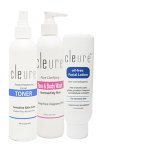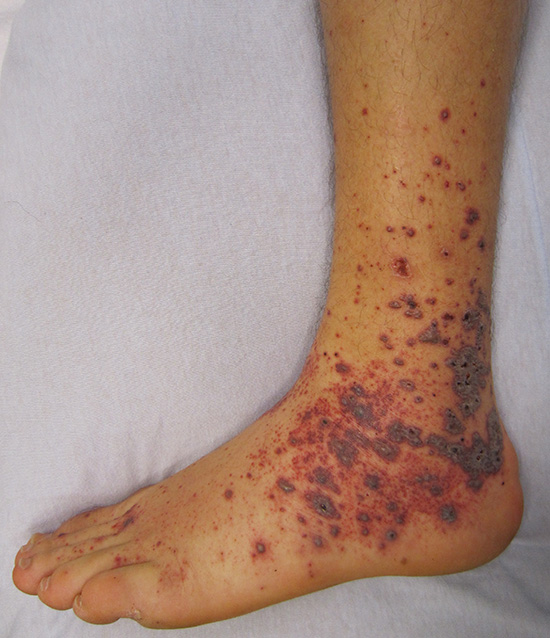Nickel Allergy Symptoms and Treatment
Recovering from an Allergy to Nickel
I discovered I had a nickel allergy after spending months trying to get rid of an itchy skin rash that developed right under my wedding ring. I've learned a lot about how you can recover from an allergy to nickel, and also how eating a low nickel diet may help to reduce your skin rash.
Even though it is challenging to discover that you have a sensitivity to nickel, there is hope! With a little education, you can clear up your rash and avoid future outbreaks without a lot of expense or time involved.
My Nickel Allergy Story
I had no idea that it was possible to actually be allergic to nickel! After 20 years of wearing a wedding ring, I broke out in a severe case of contact dermatitis ... red, itchy, inflamed skin that spread from my finger to the rest of my hand and palm.
I am very blessed to be happily married, however I was not happy to suddenly develop this large, red rash. It first appeared on the skin under my wedding ring, and later spread to the other fingers and hand. It hurt and the skin was wrinkled, and it made me very un-happy to look at!
This went on and on for years, however after diligent efforts to avoid many sources of nickel, I am now able to wear my wedding rings again!
Nickel is a natural substance, found abundantly in the Earth, and also in the ocean floor, and even in meteorites. I didn't think it was especially toxic, but I was wrong. Doctors say 10 to 20% of people can develop an allergic reaction to nickel.
Nickel Allergy Can Appear Suddenly
Some people, myself included, can use objects that contain nickel for their whole life, and then one day, they break out with a rash. For me, it happened decades after I first began wearing my wedding ring.
I experimented with taking off my ring, and within a week the rash began to clear up. I tried wearing another type of ring, and the rash came back.
Then I tried another type of ring, thinking perhaps it was the metal that I was reacting to. I tried a white gold ring, and the rash got MUCH worse!
Then I realized that I needed to get more information, so I did some research and learned about nickel allergy. Apparently, nickel is used in many gold rings and gold jewelry, and so many people with allergies to nickel will develop a reaction to wearing gold jewelry.
And I learned that white gold has MUCH more nickel in it, which is why my hand broke out so much worse! :(
According to dermatologist Dr. Dennis Gross, one in 10 people in the US are allergic to nickel. Once sensitized, most people continue to be sensitive to nickel and will need to avoid it.
Is Nickel Toxic?
Nickel is a white and silver metal that is used in all kinds of ways, usually in combination with other metals, to make coins, jewelry, stainless steel, tools and industrial items. It can also be used in some types of batteries, to create color in ceramics, and to coat other types of metals.
Nickel is released into the air during natural events volcanoes, (it is thought to be more concentrated in the core of the Earth) and is also dispersed into the atmosphere when it is mined, combined with other minerals, or used in manufacturing.
Most nickel in the soil is attached to dust and soil particles and so isn't easily absorbed into your body in that way.
It doesn't seem to accumulate in the environment although it can take a while (days, weeks or even months) to be removed from the air when it is released from a power plant. It can seep into the water as a byproduct of manufacturing.
Like many trace minerals, a small amount of nickel in our diets may be necessary for health, however very excessive amounts of nickel exposure can create allergic or even toxic reactions.
We are exposed to nickel through our air, water, and food, and also through interaction with items that contain nickel. Nickel concentrations are usually lower in the water unless you live near a plant that processes nickel.
The most serious effects that have been found from nickle exposure have been seen in people who work in nickel refineries who are exposed to very high levels of nickel. Research suggests that some types of nickel may be carcinogenic.
Nickel was voted Allergen of the Year in 2008 by the American Contact Dermatitis Association. You'll see on that list many of the other substances I've written about on this website as well!
No wonder so many people get nickel allergy!
Symptoms of an Nickel Allergy
The symptoms of an allergy to nickel are similar to contact dermatitis - redness, dry patches, changes in color, wrinkling, itching, rash, and bumps on the skin. The rash can be severe enough to cause blisters and draining. My rash actually hurt to touch.
Sometimes a nickel allergy rash will clear up on its own if you find out the cause and remove it, however please see your doctor with any kind of new skin problem. Please seek medical attention if you experience pain, heat, or pus coming from the rash.
Living With a Nickel Allergy
It is likely that when your body is very stressed out, your immune system has more trouble coping with an irritant like nickel. That may be why you can live with something for years, and suddenly it makes you break out!
The first thing you need to do is to reduce your exposure to nickel by eliminating the most obvious sources.
For example, if your earlobes break out after you wear that nice set of earrings, then you will want to remove them ... or find a special jewelry coating that can protect you from nickel exposure.
This is most difficult with important and significant pieces of jewelry ... like your wedding ring! I finally decided that even though I loved my rings, I had to find a new set that did not make my hand break out!
When you have a nickel allergy, reducing your exposure is not as easy as it sounds. Just take a look at some of the places that you will find nickel.
Items That May Contain Nickel
- Nickel is found in a lot of costume jewelry, watches and also clothing parts such as zippers, bra or girdle clips, even buttons, suspender clips, belt buckles and eyeglasses.
- Everyday items you may have that contain nickel are keys, tools, knives,cell phones, silverware and even pens.
- Nickel is also found in hairpins, some makeup compacts, lipstick holders, razors, cigarette lighters.
- In the kitchen you can be exposed to nickel through metal teapots, toasters, kitchen utensils or even some cupboard handles.
- Like to sew? This could aggravate your nickel allergy, as a lot of sewing equipment contains nickel, especially needles, thimbles, and scissors.
- At work, you can be exposed to nickel through typewriter keys, or any number of tools or machinery that you may use.
- I'm sorry to say that nickel is even found in artificial limbs, which would obviously cause a big problem for anyone with a nickel allergy.
How to Recover from a Nickel Allergy?
The most important thing to do is to find out exactly what is causing your allergic reaction, and to eliminate your exposure. Usually, once you are sensitized, nickel will always cause a problem for you, so it is important that you discover the cause and remove it from your environment.
For example, if your rash shows up on your belly button, you may be reacting to the metal button on your jeans. Or, if your rash shows up on one side of your face, and then disappears during your 9 day meditation retreat, (!) you may be allergic to your cell phone, which contains nickel.
If you may be new to the concept of a 9 day meditation retreat, this usually involves keeping silence and not talking on the phone! :)
Here are some tips for recovering from a nickel allergy.
- To reduce the rash, you can try applying some diluted vinegar. I prefer the healthy organic apple cider vinegar, but other types will work as well.
- Use hypoallergenic jewelry such as stainless steel, platinum, or plastic...although plastic has it's own problems!
- If you like gold jewelry, choose 14 carat gold or above. This is recommended, however it didn't help me! You will have to see what your body can tolerate. Some people use polycarbonate plastic but this may have other health effects. White gold and 9 carat gold definitely contain nickel and should be avoided.
- Ask for nickel free eyeglass frames.
- If you have nickel dermatitis but are in love with your wedding ring or other nickel containing jewelry, have it plated with platinum, sterling silver or other non allergic metal.
- There are products sold that you can paint onto nickel jewelry that will allow you to wear them without getting a reaction. Don't coat your jewelry with nail polish, it won't help.
- If your nickel allergy is severe, choose nickel free belt buckles and other personal care items.
- Instead of using regular silverware, try porcelin spoons and wooden chopsticks. There are also nickel free silverware options but they rust quite easily.
- Instead of using metal cookware, try using Corningware, Le Creuset or other metal free cookware.
- Many people develop nickel allergies after getting their ears pierced. If you know that you have a tendency towards allergies, and you are planning to get your ears pierced, this can be minimized by using a stainless steel needle and using 18 carat gold or above earrings.
- Take Vitamin C with each meal, which has been shown to neutralize some of the effects of high nickel levels in foods.
- Eat a high iron diet
- Some doctors recommend zinc supplementation because nickel is said to mimic zinc's action in the body if there is not enough in the diet.
- Eliminate everyday irritants, especially those that are close to your skin by choosing nickel free products such as nickel free belt buckles and nickel free jewelry.
Heavy Metal Detoxification
Some doctors believe that if your body contains an excessive amount of heavy metals, that this can increase the potential for allergies, sensitivities and allergies to nickel. For this reason, you may want to talk to a naturoprathic doctor or holistic MD about doing a heavy metal detoxification program.
For example, the right combination of chlorella and cilantro can have a powerful effect on removing heavy metals from the body, however you will want to be sure that your elimination systems such as your colon and kidneys are working smoothly so you don't encounter detoxification effects. For this reason many people perform a colon cleanse first before doing any other kind of body cleansing.
If you are highly allergic or have multiple health challenges or a compromized immune system, I recommend you get professional help to do a heavy metal detoxification program.
Will Eating a Low Nickel Diet Help?
It is almost impossible to avoid the presence in nickel in foods, however there are some foods that contain more than others, so this may be helpful for you if you are severely allergic to nickel.
Some people have found that reducing the amount of nickel in your diet can help to reduce the severity of the skin rashes.
I do recommend you consult with a nutritionist if possible to make sure you can still eat a healthy and balanced vareity of foods and get enough nutrition even if you are trying a low nickel diet.
Also, there are some cooking tips that will help you to minimize excess nickel in your food.
- Cook with cast iron - yes, it's heavy and a bit more challenging to clean, but you will avoid the nickel levels of stainless steel, and you'll be sure to get enough iron in your diet, which is another recommended way to avoid excess levels of nickel in the body.
- Avoid using the type of stainless steel that is used for cooking acid foods like tomatoes.
- Run your tap water for a few minutes so that the water you drink and cook with contains a lower nickel level from the water pipes. You can do this by filling a quart container with water and using that for cleaning or another purpose that does not involve drinking or eating.
Foods High in Nickel
Here is a partial list of some of the foods that tend to have high nickel levels.
- Canned foods
- Chocolate
- Many legumes such as lentils, beans, soy, chick peas, kidney beans, peas and split peas
- Some cruciferous veggies ... cauliflower, cabbage, brussel sprouts, broccoli
- Some of your favorite soup veggies... mushrooms, carrots, corn, onions
- Dried fruit
- Fish
- Many whole grains such as whole wheat flour, oatmeal, millet, buckwheat
- Soy ... this includes soy sauce, tofu, tempeh, etc.
- Nuts
- Seeds
- Baking powder
- Gelatin
- Licorice
- Margarine
- Bottled salad dressings (it is healthier and less expensive to make your own!)
- Some vitamins, minerals, herbs and medications also contain nickel!
You can find a list of nickel in foods on page 106 on this FDA Food Safety document.
Finding Nickel Free Products
It is getting easier to find nickel free belt buckles, buttons, jewelry and other products. You can find specialty retailers, and there is a huge selection of nickel free products available at Amazon.com which usually has the lowest prices.
More Resources on Nickel Allergy
These are some helpful sites that provide more detailed insight and information on nickel allergy and nickel dermatitis.
Overview of Nickel and Potential Toxicity
Pictures of Nickel Dermatitis and Allergy to Nickel
Holistic Medical Doctor's Perspective on Nickel Toxicity
Background And Environmental Exposures To Nickel In The United States
Profile of Nickel in Toxic Substances Portal
Home > Common Allergies and Symptoms > Nickel Allergy









New! Comments
Share your thoughts about what you just read! Leave me a comment in the box below.